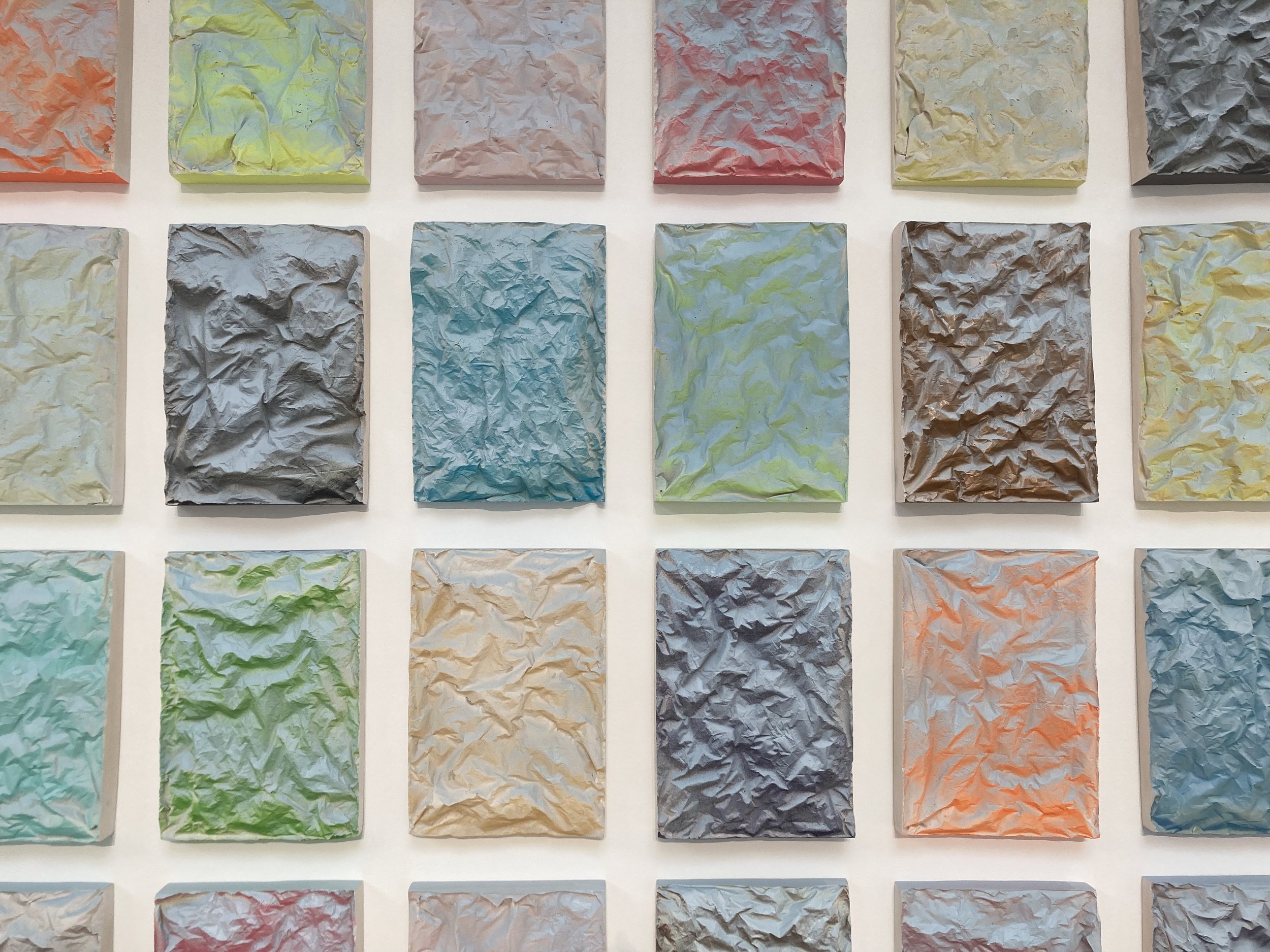Rana Begum Paints the Town Red…and Every Other Colour
Rana Begum’s artwork cannot be truly photographed. A picture can be taken, but it won’t suffice. Her consummate play with reflection and colour, volume and lustre, and light and diffusion solicit movement, prompting the viewer to dance like a marionette; back and forth, to and fro, and all around to really get a glimpse.
The London-based, Anglo-Bangladeshi artist’s two most recent exhibitions in London exemplify her practice, from Dappled Light at Pitzhanger Manor in Ealing to Reflection on Colour and Form at Cristea Roberts Gallery in St. James closing next week.
Rana Begum, No. 1081 Mesh, 2021. Powder-coated galvanised metal steel at Pitzhanger Manor. Photo by Camille Moreno.
The animal kingdom includes a crustacean named the mantis shrimp. Evolved with an anatomically superior sense of sight, these shellfish have sixteen colour-receptive cones compared to humans’ piddly three. Through trinocular vision, these animals detect colour through spiralised light called “circularly polarised” (1) light that enables them to see like a satellite, similar to the technology used to read CDs and DVDs. Ever look at a seemingly silver CD and wonder where all the colours come from? They come from light being refracted in a similar way. The shrimp’s minerally, technicolour chassis looks like it drove through a rainbow carwash. Eying up Begum’s work, one wonders whether she might be part mantis shrimp.
How else could she derive these colours? Surely she has some kind of exclusive access. Begum does not actually apply colour, she extracts it. The activation of light and reflection uncovers colours within colours. This also denotes a theatrical excitement intrinsic to viewing her works, which can best be described as an experience. It is clear that she is keenly aware of how the works are seen, as well as the profound influence that has on their material presence.
Rana Begum, No. 1081 Mesh (detail), 2021. Powder-coated galvanised metal steel at Pitzhanger Manor. Photo by Camille Moreno.
The two exhibitions are situated in distinctly different corners of the city: from the historic Pitzhanger Manor, the former country estate of Sir John Soane, nestled in the tranquil westerly borough of Ealing, to contemporary white cube gallery Cristea Roberts, smack in the middle of Central London’s bustling Pall Mall. Despite contrasting locales, the presentations are bridged by Begum’s unique prismatic sensibility and material language.
Her signature recurring mesh bows like supple netting—one would not know the nebulous clouds and curled planes are in fact made of solid steel. The subtle layering of the mesh transposes colours as textures, allowing undertones of light to shine through the sculptures and play their own material role.
Rana Begum, No. 1082 Folded Grid, 2021. Spray paint on Jesmonite at Pitzhanger Manor. Photo by Camille Moreno.
Begum often exposes what we may not have previously been able to see ourselves. Her large-scale painting No. 1113 reveals the brightness and diversity of various warm and cool tones by playing off their proximity to one another. What looks to be, at first glance, a collection of spots, comprises sunny and dark corners, areas of illumination, and a complex narrative of colour relationships.
The canvas also references the exhibition title, Dappled Light, which refers to the light produced when sunlight is filtered through the leaves of a tree. The leaves overlap and combine, acting like hundreds of tiny pinhole cameras that project multiple reflections of the sun’s surface onto the objects on which the light falls. (2) The phenomenon is apparent in the scintillating movement of an otherwise static canvas.
Rana Begum, No. 1113 Painting Large, 2022. Acrylic and spray paint on canvas at Pitzhanger Manor. Photo by Camille Moreno.
At Pitzhanger, Begum took great care to consider the architecture of the building as well as Soane’s extensive use of stained glass throughout the villa. From inside to outside, the visual dialogue and curatorial fluency offer discreet juxtapositions between historic architecture and the vivid, contemporary aesthetic of the artist, who also served as co-curator of the architecture room at this summer’s Royal Academy Exhibition.
In the garden, five of Begum’s coloured glass panels greet visitors, engaging not only with gallery goers but also with the wider Ealing community members, who visit the grounds regularly. Pitzhanger’s director, Clare Gough, added that the outdoor sculpture has helped “draw in a new audience to enjoy [Begum’s] very relatable art.” (3) Additionally, Begum has initiated a project with local artists from Bollo Brook Studios, of Bollo Brook Youth Centre, to create a collaborative wall drawing composed of every contributor’s thumbprints.
Rana Begum, installation view at Pitzhanger Manor. Photo by Andy Stagg.
By way of her diverse material output and curatorial adaptation, Begum continually redefines her practice with exceedingly brilliant activations of space. Over the summer, she collaborated with the English National Ballet and fashion designer Roksanda Ilincic to create a dance piece inspired by her sculptural work, No.1104. Recent solo exhibitions include a 2018 presentation at Tate St. Ives, a residency at Porthmeor Studios in Nottingham, and a show at the Sainsbury Centre in Norwich.
Begum’s work exhibits a restrained juggling of aesthetic paradoxes. It’s precise, yet imperfect, systematic yet kinky, and structured yet amorphous. She adheres to a framework but simultaneously continues to veer away, allowing us to feel like we have traversed beyond the confines of the human hue cycle, without ever having left the spectrum. Perhaps the mantis shrimp does not see different colours altogether, but rather a larger range of colours in between.
Rana Begum, No. 1142 Zigzag, 2022. Paint on powder-coated mild steel, 284.5 x 82.5 cm, at Cristea Roberts Gallery. Photo by Camille Moreno.
Rana Begum, Dappled Light, is on view through 11 September at Pitzhanger Manor & Gallery, Mattock Lane, W5 5EQ, London.
Rana Begum, Reflection on Colour and Form, is on view through 17 September at Cristea Roberts Gallery, 43 Pall Mall St., SW1Y 5JG, London.
Camille Moreno
Features Co-Editor, MADE IN BED



